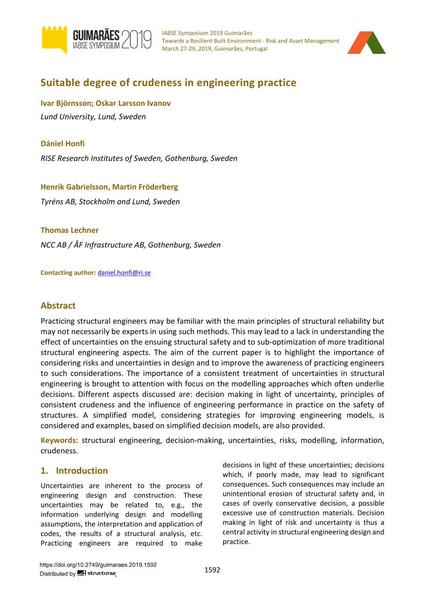Suitable degree of crudeness in engineering practice

|
|
|||||||||||
Bibliografische Angaben
| Autor(en): |
Ivar Björnsson
Oskar Larsson Ivanov (Lund University, Lund, Sweden) Dániel Honfi Henrik Gabrielsson (Tyréns AB, Stockholm and Lund, Sweden) Martin Fröderberg (Tyréns AB, Stockholm and Lund, Sweden) Thomas Lechner (NCC AB / ÅF Infrastructure AB, Gothenburg, Sweden) |
||||
|---|---|---|---|---|---|
| Medium: | Tagungsbeitrag | ||||
| Sprache(n): | Englisch | ||||
| Tagung: | IABSE Symposium: Towards a Resilient Built Environment Risk and Asset Management, Guimarães, Portugal, 27-29 March 2019 | ||||
| Veröffentlicht in: | IABSE Symposium Guimarães 2019 | ||||
|
|||||
| Seite(n): | 1592-1599 | ||||
| Anzahl der Seiten (im PDF): | 8 | ||||
| DOI: | 10.2749/guimaraes.2019.1592 | ||||
| Abstrakt: |
Practicing structural engineers may be familiar with the main principles of structural reliability but may not necessarily be experts in using such methods. This may lead to a lack in understanding the effect of uncertainties on the ensuing structural safety and to sub-optimization of more traditional structural engineering aspects. The aim of the current paper is to highlight the importance of considering risks and uncertainties in design and to improve the awareness of practicing engineers to such considerations. The importance of a consistent treatment of uncertainties in structural engineering is brought to attention with focus on the modelling approaches which often underlie decisions. Different aspects discussed are: decision making in light of uncertainty, principles of consistent crudeness and the influence of engineering performance in practice on the safety of structures. A simplified model, considering strategies for improving engineering models, is considered and examples, based on simplified decision models, are also provided. |
||||
| Stichwörter: |
Modellbildung Risiken Unsicherheiten Tragwerksplanung
|
||||
